skip to main |
skip to sidebar
 Don’t worry, with the next post we’ll be heading back out to the desert. Even in the searing heat I’ve managed to check out a few new locales. But these are so remote and mysterious that I’ve been able to find very little to say about them, historically speaking. So, while I consider how to present these lost gems, we’ll make a short stop in Budapest to visit an abandonment that is a decidedly un-lost gem, the Szimpla Kert "ruin pub."
Romkocsma, which translates literally as “ruin pubs,” seem to be a phenomenon somewhat unique to Budapest. Having emerged from Nazi occupation and subsequent Communist rule with numerous poorly-maintained buildings, Budapest found itself without the resources to restore them properly or tear them down.
Don’t worry, with the next post we’ll be heading back out to the desert. Even in the searing heat I’ve managed to check out a few new locales. But these are so remote and mysterious that I’ve been able to find very little to say about them, historically speaking. So, while I consider how to present these lost gems, we’ll make a short stop in Budapest to visit an abandonment that is a decidedly un-lost gem, the Szimpla Kert "ruin pub."
Romkocsma, which translates literally as “ruin pubs,” seem to be a phenomenon somewhat unique to Budapest. Having emerged from Nazi occupation and subsequent Communist rule with numerous poorly-maintained buildings, Budapest found itself without the resources to restore them properly or tear them down.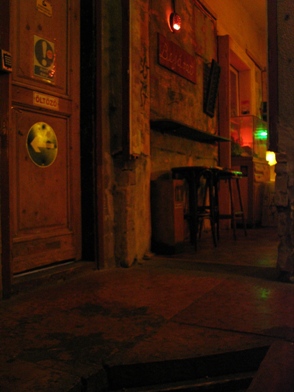 Many of these buildings were once apartments and are located in residential neighborhoods, sometimes sandwiched between occupied buildings, and, from the outside, all you usually see is a run-down façade. But inside it’s a different story. By negotiating cheap rent and enlisting the help of anyone that can help make these places structurally sound, vibrant, lively pubs have sprung up amidst the ruins. Acting not just as watering holes, but as community gathering-places presenting music, film, and alternative arts and culture, you can’t help but hope this trend continues.
Many of these buildings were once apartments and are located in residential neighborhoods, sometimes sandwiched between occupied buildings, and, from the outside, all you usually see is a run-down façade. But inside it’s a different story. By negotiating cheap rent and enlisting the help of anyone that can help make these places structurally sound, vibrant, lively pubs have sprung up amidst the ruins. Acting not just as watering holes, but as community gathering-places presenting music, film, and alternative arts and culture, you can’t help but hope this trend continues.
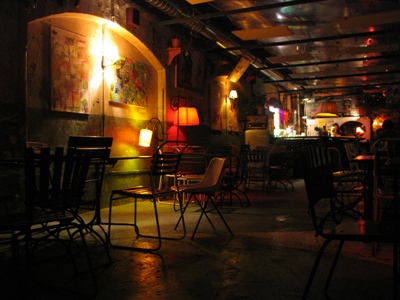 Szimpla Kert is the first and most well-known of the Romkocsma, located in the Old Jewish Quarter, also known as District VII, a fascinating and disheveled area of the city that experienced untold suffering under the Nazis. A huge, labyrinthine, multi-level concrete beast, Szimpla Kert features internal ladders and spiral staircases, busted-up walls and enough dark corners to accommodate whatever you’re into. “Kert” refers to the courtyard or “garden,” which is an open-air portion of the complex located on the site of a building that's been demolished. It is, simply, the coolest bar I’ve ever been in. Even cooler than Heinold’s First and Last Chance Saloon in Oakland, CA, a favorite of Jack London’s with its five tables and woefully sloping floor (a result of the 1906 quake). Actually, let’s not slight Heinold’s. Let’s just say Szimpla Kert is AS COOL as Heinold’s.
Szimpla Kert is the first and most well-known of the Romkocsma, located in the Old Jewish Quarter, also known as District VII, a fascinating and disheveled area of the city that experienced untold suffering under the Nazis. A huge, labyrinthine, multi-level concrete beast, Szimpla Kert features internal ladders and spiral staircases, busted-up walls and enough dark corners to accommodate whatever you’re into. “Kert” refers to the courtyard or “garden,” which is an open-air portion of the complex located on the site of a building that's been demolished. It is, simply, the coolest bar I’ve ever been in. Even cooler than Heinold’s First and Last Chance Saloon in Oakland, CA, a favorite of Jack London’s with its five tables and woefully sloping floor (a result of the 1906 quake). Actually, let’s not slight Heinold’s. Let’s just say Szimpla Kert is AS COOL as Heinold’s.
 Of course, as with any concept that works this well, there has been growing discontent and early patrons of Szimpla Kert lament the international hipster crowd, the more expensive drinks, and the general popularity of the place. Szimpla was voted 3rd best bar in the world by Lonely Planet last year, so the crowds aren’t exactly abating. But, you know, it’s hard for me to begrudge Szimpla’s success. The ambience is unbeatable; strange “art” hangs on the walls, mysterious Stalinist-looking electronics are scattered here and there, the place is furnished with everything from lawn chairs to claw foot bathtubs, and it seems genuinely weird--in an authentic way--to me. And I think I'm a pretty good judge of the authentically weird. On the other hand, with money comes gentrification, and, as often happens, the very thing that brought people to the Old Jewish Quarter in the first place might well become the agent of its cultural destruction. But that phenomenon is not unique to Budapest and its cure remains elusive. In the meantime, all you can do is join the crowd and have a look at the incredible Szimpla Kert ruin pub.
Of course, as with any concept that works this well, there has been growing discontent and early patrons of Szimpla Kert lament the international hipster crowd, the more expensive drinks, and the general popularity of the place. Szimpla was voted 3rd best bar in the world by Lonely Planet last year, so the crowds aren’t exactly abating. But, you know, it’s hard for me to begrudge Szimpla’s success. The ambience is unbeatable; strange “art” hangs on the walls, mysterious Stalinist-looking electronics are scattered here and there, the place is furnished with everything from lawn chairs to claw foot bathtubs, and it seems genuinely weird--in an authentic way--to me. And I think I'm a pretty good judge of the authentically weird. On the other hand, with money comes gentrification, and, as often happens, the very thing that brought people to the Old Jewish Quarter in the first place might well become the agent of its cultural destruction. But that phenomenon is not unique to Budapest and its cure remains elusive. In the meantime, all you can do is join the crowd and have a look at the incredible Szimpla Kert ruin pub.
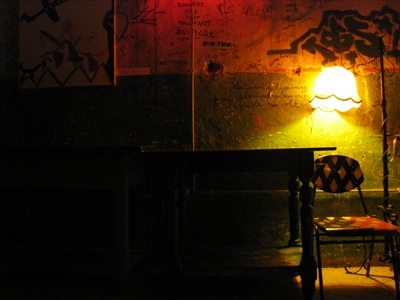 By the way, the graffiti in the photo above reads, "Borders are not relevant anymore," a lovely sentiment given the history of Hungary (and Eastern Europe, in general).
By the way, the graffiti in the photo above reads, "Borders are not relevant anymore," a lovely sentiment given the history of Hungary (and Eastern Europe, in general).
 While southwestern New Mexico burns, covering much of the state in dingy smoke, I think we’ll stay overseas and visit Beelitz Heilstätten, a 200-acre hospital complex comprised of 60 buildings and located in the town of Beelitz, just a few kilometers south of Potsdam. Beelitz’s other claim to fame is its delicious white asparagus, but as pictures of asparagus aren’t always interesting, we spent all our time at the hospital.
The Beelitz Heilstätten complex (“Heilstätten” translates roughly as “a place of healing) was constructed in 1898 and designed by Heino Schmieden, partner in one of Berlin’s greatest architecture firms of the time. Aside from the numerous ornate buildings, rigorously separated by gender, the grand complex also contained its own generating station to produce power and heat. Below is the entrance to the men's sanatorium.
While southwestern New Mexico burns, covering much of the state in dingy smoke, I think we’ll stay overseas and visit Beelitz Heilstätten, a 200-acre hospital complex comprised of 60 buildings and located in the town of Beelitz, just a few kilometers south of Potsdam. Beelitz’s other claim to fame is its delicious white asparagus, but as pictures of asparagus aren’t always interesting, we spent all our time at the hospital.
The Beelitz Heilstätten complex (“Heilstätten” translates roughly as “a place of healing) was constructed in 1898 and designed by Heino Schmieden, partner in one of Berlin’s greatest architecture firms of the time. Aside from the numerous ornate buildings, rigorously separated by gender, the grand complex also contained its own generating station to produce power and heat. Below is the entrance to the men's sanatorium.
 Conceived as a tuberculosis sanatorium by the Berlin Workers’ Health Insurance Corporation, the main treatments seem to have been “baths.” Water baths in pools, air baths on balconies, just generally taking it easy, I guess. There wasn’t much in the way of effective surgery at the time, of course, and the grounds appear to have mostly been designed with extended strolls in mind.
Then, at the beginning of WWI, the complex quickly became a military hospital for the Imperial German Army. Perhaps the most (in)famous patient to stay at Beelitz Heilstätten during this time was Adolf Hitler who, after being wounded in the leg at the Battle of the Somme, spent October and November of 1916 recuperating here.
Conceived as a tuberculosis sanatorium by the Berlin Workers’ Health Insurance Corporation, the main treatments seem to have been “baths.” Water baths in pools, air baths on balconies, just generally taking it easy, I guess. There wasn’t much in the way of effective surgery at the time, of course, and the grounds appear to have mostly been designed with extended strolls in mind.
Then, at the beginning of WWI, the complex quickly became a military hospital for the Imperial German Army. Perhaps the most (in)famous patient to stay at Beelitz Heilstätten during this time was Adolf Hitler who, after being wounded in the leg at the Battle of the Somme, spent October and November of 1916 recuperating here.
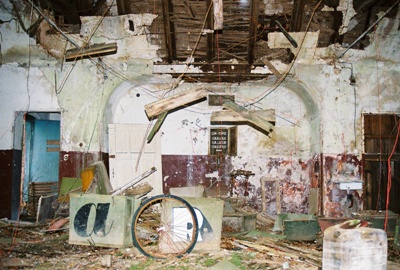 After being used as a Nazi military hospital during WWII, Beelitz Heilstätten was occupied by the Soviets in 1945 and, at its height, employed 1,000 people. Strangely, it remained a Russian-operated facility until 1995, a few years after German re-unification. In fact, shortly after the fall of the Berlin Wall, in December 1990, Erich Honecker spent time here. He had just been forced to resign as head of the suddenly non-existent East German government and apparently wasn’t feeling too good about things. I suppose the liver cancer probably didn’t help.
It was also during the unsettled period between the Wall coming down and re-unification that Die Bestie Von Beelitz or, The Beast of Beelitz, appeared. From the fall of 1989 to the spring of 1991, the Beast, a necrophiliac, terrorized the women of Beelitz, strangling or stabbing his victims and at least once leaving his own pink underwear behind.
After being used as a Nazi military hospital during WWII, Beelitz Heilstätten was occupied by the Soviets in 1945 and, at its height, employed 1,000 people. Strangely, it remained a Russian-operated facility until 1995, a few years after German re-unification. In fact, shortly after the fall of the Berlin Wall, in December 1990, Erich Honecker spent time here. He had just been forced to resign as head of the suddenly non-existent East German government and apparently wasn’t feeling too good about things. I suppose the liver cancer probably didn’t help.
It was also during the unsettled period between the Wall coming down and re-unification that Die Bestie Von Beelitz or, The Beast of Beelitz, appeared. From the fall of 1989 to the spring of 1991, the Beast, a necrophiliac, terrorized the women of Beelitz, strangling or stabbing his victims and at least once leaving his own pink underwear behind.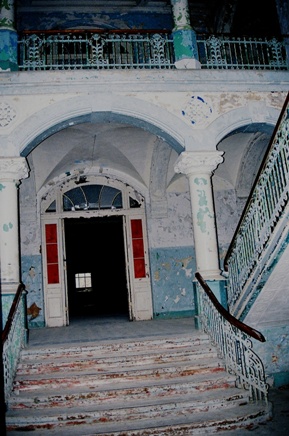 Most of the attacks occurred near the surgical block and women’s pavilion on the forested Heilstätten grounds and his victims included the wife and infant child of a senior physician. Before being detained by joggers while pleasuring himself in the woods, the Beast, whose real name is Wolfgang Schmidt, killed a total of six women and the infant. He was sentenced to 15 years detention in a psychiatric facility which seems a little, I don’t know, LIGHT to me. However, I believe he remains imprisoned now, 20+ years later. A QUOTE from 2001 has Schmidt asking the court that he be treated as a woman named "Beate" (the court agreed) and complaining about taunting by other inmates.
As if all that wasn’t enough, in 2008, a pornographer brought a young model named Anja P. to the former operating suite for a photo session. After the shoot he took her to the gatehouse where he beat her to death with a frying pan and had sex with her corpse. The head of a family that actually lives in an outbuilding on the grounds, Michael W. says he and his son are both martial arts experts and “could handle about eight people together and win.” Geez, those are the kind of skills you just might need if you’re going to spend much time around Beelitz Heilstätten. That's a gymnasium in the photo below.
Most of the attacks occurred near the surgical block and women’s pavilion on the forested Heilstätten grounds and his victims included the wife and infant child of a senior physician. Before being detained by joggers while pleasuring himself in the woods, the Beast, whose real name is Wolfgang Schmidt, killed a total of six women and the infant. He was sentenced to 15 years detention in a psychiatric facility which seems a little, I don’t know, LIGHT to me. However, I believe he remains imprisoned now, 20+ years later. A QUOTE from 2001 has Schmidt asking the court that he be treated as a woman named "Beate" (the court agreed) and complaining about taunting by other inmates.
As if all that wasn’t enough, in 2008, a pornographer brought a young model named Anja P. to the former operating suite for a photo session. After the shoot he took her to the gatehouse where he beat her to death with a frying pan and had sex with her corpse. The head of a family that actually lives in an outbuilding on the grounds, Michael W. says he and his son are both martial arts experts and “could handle about eight people together and win.” Geez, those are the kind of skills you just might need if you’re going to spend much time around Beelitz Heilstätten. That's a gymnasium in the photo below.
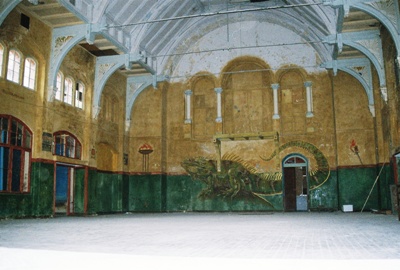 Recently, there have been some efforts to privatize the complex but bankruptcy has gotten in the way. The surgery, psychiatric ward, and rifle range (??) have been abandoned for some time and a supposedly functioning center for neurological research and a rehabilitation area for Parkinson’s sufferers were not obviously operating during our visit.
Recently, there have been some efforts to privatize the complex but bankruptcy has gotten in the way. The surgery, psychiatric ward, and rifle range (??) have been abandoned for some time and a supposedly functioning center for neurological research and a rehabilitation area for Parkinson’s sufferers were not obviously operating during our visit.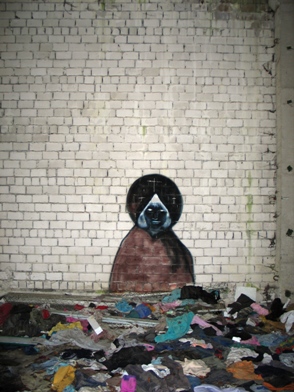 In fact, aside from the caretaker’s quarters and some random renovation here and there, we saw virtually no activity. Unfortunately for us—and in contrast to statements from a year or two ago—most of the buildings were locked-up, boarded-over, and totally inaccessible without more time and at least a rope or two. Still, it was quite an experience to wander the grounds on a damp, overcast day, take in the unusual Russian graffiti, and consider all the terrible goings-on that have occurred at Beelitz Heilstätten.
Although I had not heard of Beelitz Heilstätten before visiting, it turns out to be quite well known indeed. I found very good information and the Michael K. quote at EXBERLINER, this URB EX site was informative, and I grabbed some info on Schmidt from HERE. If you want to see some more of Beelitz Heilstätten complex, just do a Google search. It's all over the place. The complex has also appeared in both The Pianist and Valkyrie, as well as some S&M films. But you’re on your own if you want to get the names of those.
In fact, aside from the caretaker’s quarters and some random renovation here and there, we saw virtually no activity. Unfortunately for us—and in contrast to statements from a year or two ago—most of the buildings were locked-up, boarded-over, and totally inaccessible without more time and at least a rope or two. Still, it was quite an experience to wander the grounds on a damp, overcast day, take in the unusual Russian graffiti, and consider all the terrible goings-on that have occurred at Beelitz Heilstätten.
Although I had not heard of Beelitz Heilstätten before visiting, it turns out to be quite well known indeed. I found very good information and the Michael K. quote at EXBERLINER, this URB EX site was informative, and I grabbed some info on Schmidt from HERE. If you want to see some more of Beelitz Heilstätten complex, just do a Google search. It's all over the place. The complex has also appeared in both The Pianist and Valkyrie, as well as some S&M films. But you’re on your own if you want to get the names of those.
 Don’t worry, with the next post we’ll be heading back out to the desert. Even in the searing heat I’ve managed to check out a few new locales. But these are so remote and mysterious that I’ve been able to find very little to say about them, historically speaking. So, while I consider how to present these lost gems, we’ll make a short stop in Budapest to visit an abandonment that is a decidedly un-lost gem, the Szimpla Kert "ruin pub."
Romkocsma, which translates literally as “ruin pubs,” seem to be a phenomenon somewhat unique to Budapest. Having emerged from Nazi occupation and subsequent Communist rule with numerous poorly-maintained buildings, Budapest found itself without the resources to restore them properly or tear them down.
Don’t worry, with the next post we’ll be heading back out to the desert. Even in the searing heat I’ve managed to check out a few new locales. But these are so remote and mysterious that I’ve been able to find very little to say about them, historically speaking. So, while I consider how to present these lost gems, we’ll make a short stop in Budapest to visit an abandonment that is a decidedly un-lost gem, the Szimpla Kert "ruin pub."
Romkocsma, which translates literally as “ruin pubs,” seem to be a phenomenon somewhat unique to Budapest. Having emerged from Nazi occupation and subsequent Communist rule with numerous poorly-maintained buildings, Budapest found itself without the resources to restore them properly or tear them down. Many of these buildings were once apartments and are located in residential neighborhoods, sometimes sandwiched between occupied buildings, and, from the outside, all you usually see is a run-down façade. But inside it’s a different story. By negotiating cheap rent and enlisting the help of anyone that can help make these places structurally sound, vibrant, lively pubs have sprung up amidst the ruins. Acting not just as watering holes, but as community gathering-places presenting music, film, and alternative arts and culture, you can’t help but hope this trend continues.
Many of these buildings were once apartments and are located in residential neighborhoods, sometimes sandwiched between occupied buildings, and, from the outside, all you usually see is a run-down façade. But inside it’s a different story. By negotiating cheap rent and enlisting the help of anyone that can help make these places structurally sound, vibrant, lively pubs have sprung up amidst the ruins. Acting not just as watering holes, but as community gathering-places presenting music, film, and alternative arts and culture, you can’t help but hope this trend continues.
 Szimpla Kert is the first and most well-known of the Romkocsma, located in the Old Jewish Quarter, also known as District VII, a fascinating and disheveled area of the city that experienced untold suffering under the Nazis. A huge, labyrinthine, multi-level concrete beast, Szimpla Kert features internal ladders and spiral staircases, busted-up walls and enough dark corners to accommodate whatever you’re into. “Kert” refers to the courtyard or “garden,” which is an open-air portion of the complex located on the site of a building that's been demolished. It is, simply, the coolest bar I’ve ever been in. Even cooler than Heinold’s First and Last Chance Saloon in Oakland, CA, a favorite of Jack London’s with its five tables and woefully sloping floor (a result of the 1906 quake). Actually, let’s not slight Heinold’s. Let’s just say Szimpla Kert is AS COOL as Heinold’s.
Szimpla Kert is the first and most well-known of the Romkocsma, located in the Old Jewish Quarter, also known as District VII, a fascinating and disheveled area of the city that experienced untold suffering under the Nazis. A huge, labyrinthine, multi-level concrete beast, Szimpla Kert features internal ladders and spiral staircases, busted-up walls and enough dark corners to accommodate whatever you’re into. “Kert” refers to the courtyard or “garden,” which is an open-air portion of the complex located on the site of a building that's been demolished. It is, simply, the coolest bar I’ve ever been in. Even cooler than Heinold’s First and Last Chance Saloon in Oakland, CA, a favorite of Jack London’s with its five tables and woefully sloping floor (a result of the 1906 quake). Actually, let’s not slight Heinold’s. Let’s just say Szimpla Kert is AS COOL as Heinold’s.
 Of course, as with any concept that works this well, there has been growing discontent and early patrons of Szimpla Kert lament the international hipster crowd, the more expensive drinks, and the general popularity of the place. Szimpla was voted 3rd best bar in the world by Lonely Planet last year, so the crowds aren’t exactly abating. But, you know, it’s hard for me to begrudge Szimpla’s success. The ambience is unbeatable; strange “art” hangs on the walls, mysterious Stalinist-looking electronics are scattered here and there, the place is furnished with everything from lawn chairs to claw foot bathtubs, and it seems genuinely weird--in an authentic way--to me. And I think I'm a pretty good judge of the authentically weird. On the other hand, with money comes gentrification, and, as often happens, the very thing that brought people to the Old Jewish Quarter in the first place might well become the agent of its cultural destruction. But that phenomenon is not unique to Budapest and its cure remains elusive. In the meantime, all you can do is join the crowd and have a look at the incredible Szimpla Kert ruin pub.
Of course, as with any concept that works this well, there has been growing discontent and early patrons of Szimpla Kert lament the international hipster crowd, the more expensive drinks, and the general popularity of the place. Szimpla was voted 3rd best bar in the world by Lonely Planet last year, so the crowds aren’t exactly abating. But, you know, it’s hard for me to begrudge Szimpla’s success. The ambience is unbeatable; strange “art” hangs on the walls, mysterious Stalinist-looking electronics are scattered here and there, the place is furnished with everything from lawn chairs to claw foot bathtubs, and it seems genuinely weird--in an authentic way--to me. And I think I'm a pretty good judge of the authentically weird. On the other hand, with money comes gentrification, and, as often happens, the very thing that brought people to the Old Jewish Quarter in the first place might well become the agent of its cultural destruction. But that phenomenon is not unique to Budapest and its cure remains elusive. In the meantime, all you can do is join the crowd and have a look at the incredible Szimpla Kert ruin pub.
 By the way, the graffiti in the photo above reads, "Borders are not relevant anymore," a lovely sentiment given the history of Hungary (and Eastern Europe, in general).
By the way, the graffiti in the photo above reads, "Borders are not relevant anymore," a lovely sentiment given the history of Hungary (and Eastern Europe, in general).
 While southwestern New Mexico burns, covering much of the state in dingy smoke, I think we’ll stay overseas and visit Beelitz Heilstätten, a 200-acre hospital complex comprised of 60 buildings and located in the town of Beelitz, just a few kilometers south of Potsdam. Beelitz’s other claim to fame is its delicious white asparagus, but as pictures of asparagus aren’t always interesting, we spent all our time at the hospital.
The Beelitz Heilstätten complex (“Heilstätten” translates roughly as “a place of healing) was constructed in 1898 and designed by Heino Schmieden, partner in one of Berlin’s greatest architecture firms of the time. Aside from the numerous ornate buildings, rigorously separated by gender, the grand complex also contained its own generating station to produce power and heat. Below is the entrance to the men's sanatorium.
While southwestern New Mexico burns, covering much of the state in dingy smoke, I think we’ll stay overseas and visit Beelitz Heilstätten, a 200-acre hospital complex comprised of 60 buildings and located in the town of Beelitz, just a few kilometers south of Potsdam. Beelitz’s other claim to fame is its delicious white asparagus, but as pictures of asparagus aren’t always interesting, we spent all our time at the hospital.
The Beelitz Heilstätten complex (“Heilstätten” translates roughly as “a place of healing) was constructed in 1898 and designed by Heino Schmieden, partner in one of Berlin’s greatest architecture firms of the time. Aside from the numerous ornate buildings, rigorously separated by gender, the grand complex also contained its own generating station to produce power and heat. Below is the entrance to the men's sanatorium.
 Conceived as a tuberculosis sanatorium by the Berlin Workers’ Health Insurance Corporation, the main treatments seem to have been “baths.” Water baths in pools, air baths on balconies, just generally taking it easy, I guess. There wasn’t much in the way of effective surgery at the time, of course, and the grounds appear to have mostly been designed with extended strolls in mind.
Then, at the beginning of WWI, the complex quickly became a military hospital for the Imperial German Army. Perhaps the most (in)famous patient to stay at Beelitz Heilstätten during this time was Adolf Hitler who, after being wounded in the leg at the Battle of the Somme, spent October and November of 1916 recuperating here.
Conceived as a tuberculosis sanatorium by the Berlin Workers’ Health Insurance Corporation, the main treatments seem to have been “baths.” Water baths in pools, air baths on balconies, just generally taking it easy, I guess. There wasn’t much in the way of effective surgery at the time, of course, and the grounds appear to have mostly been designed with extended strolls in mind.
Then, at the beginning of WWI, the complex quickly became a military hospital for the Imperial German Army. Perhaps the most (in)famous patient to stay at Beelitz Heilstätten during this time was Adolf Hitler who, after being wounded in the leg at the Battle of the Somme, spent October and November of 1916 recuperating here.
 After being used as a Nazi military hospital during WWII, Beelitz Heilstätten was occupied by the Soviets in 1945 and, at its height, employed 1,000 people. Strangely, it remained a Russian-operated facility until 1995, a few years after German re-unification. In fact, shortly after the fall of the Berlin Wall, in December 1990, Erich Honecker spent time here. He had just been forced to resign as head of the suddenly non-existent East German government and apparently wasn’t feeling too good about things. I suppose the liver cancer probably didn’t help.
It was also during the unsettled period between the Wall coming down and re-unification that Die Bestie Von Beelitz or, The Beast of Beelitz, appeared. From the fall of 1989 to the spring of 1991, the Beast, a necrophiliac, terrorized the women of Beelitz, strangling or stabbing his victims and at least once leaving his own pink underwear behind.
After being used as a Nazi military hospital during WWII, Beelitz Heilstätten was occupied by the Soviets in 1945 and, at its height, employed 1,000 people. Strangely, it remained a Russian-operated facility until 1995, a few years after German re-unification. In fact, shortly after the fall of the Berlin Wall, in December 1990, Erich Honecker spent time here. He had just been forced to resign as head of the suddenly non-existent East German government and apparently wasn’t feeling too good about things. I suppose the liver cancer probably didn’t help.
It was also during the unsettled period between the Wall coming down and re-unification that Die Bestie Von Beelitz or, The Beast of Beelitz, appeared. From the fall of 1989 to the spring of 1991, the Beast, a necrophiliac, terrorized the women of Beelitz, strangling or stabbing his victims and at least once leaving his own pink underwear behind. Most of the attacks occurred near the surgical block and women’s pavilion on the forested Heilstätten grounds and his victims included the wife and infant child of a senior physician. Before being detained by joggers while pleasuring himself in the woods, the Beast, whose real name is Wolfgang Schmidt, killed a total of six women and the infant. He was sentenced to 15 years detention in a psychiatric facility which seems a little, I don’t know, LIGHT to me. However, I believe he remains imprisoned now, 20+ years later. A
Most of the attacks occurred near the surgical block and women’s pavilion on the forested Heilstätten grounds and his victims included the wife and infant child of a senior physician. Before being detained by joggers while pleasuring himself in the woods, the Beast, whose real name is Wolfgang Schmidt, killed a total of six women and the infant. He was sentenced to 15 years detention in a psychiatric facility which seems a little, I don’t know, LIGHT to me. However, I believe he remains imprisoned now, 20+ years later. A  Recently, there have been some efforts to privatize the complex but bankruptcy has gotten in the way. The surgery, psychiatric ward, and rifle range (??) have been abandoned for some time and a supposedly functioning center for neurological research and a rehabilitation area for Parkinson’s sufferers were not obviously operating during our visit.
Recently, there have been some efforts to privatize the complex but bankruptcy has gotten in the way. The surgery, psychiatric ward, and rifle range (??) have been abandoned for some time and a supposedly functioning center for neurological research and a rehabilitation area for Parkinson’s sufferers were not obviously operating during our visit. In fact, aside from the caretaker’s quarters and some random renovation here and there, we saw virtually no activity. Unfortunately for us—and in contrast to statements from a year or two ago—most of the buildings were locked-up, boarded-over, and totally inaccessible without more time and at least a rope or two. Still, it was quite an experience to wander the grounds on a damp, overcast day, take in the unusual Russian graffiti, and consider all the terrible goings-on that have occurred at Beelitz Heilstätten.
Although I had not heard of Beelitz Heilstätten before visiting, it turns out to be quite well known indeed. I found very good information and the Michael K. quote at
In fact, aside from the caretaker’s quarters and some random renovation here and there, we saw virtually no activity. Unfortunately for us—and in contrast to statements from a year or two ago—most of the buildings were locked-up, boarded-over, and totally inaccessible without more time and at least a rope or two. Still, it was quite an experience to wander the grounds on a damp, overcast day, take in the unusual Russian graffiti, and consider all the terrible goings-on that have occurred at Beelitz Heilstätten.
Although I had not heard of Beelitz Heilstätten before visiting, it turns out to be quite well known indeed. I found very good information and the Michael K. quote at